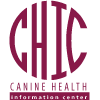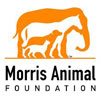Hip Dysplasia Treatment Options
General Guidelines
Once osteoarthritis is present on a radiograph, dysplastic changes are irreversible
and usually continue to progress over time. If a dysplastic dog has secondary
arthritis and pain, most owners elect to first treat their dog with medical
management. The key to medical management of arthritis is weight control
and exercise management. Studies have shown that up to 76% of severely dysplastic
dogs with arthritis secondary to HD are able to function and live comfortable
quality lives with conservative management.
With weight control, the goal is to prevent the dog from becoming overweight
to reduce mechanical stresses applied to the hip joints. In general terms,
the ribs should be easily palpated and there should be an indentation
in front of the pelvic wings (waist line).
Controlled exercise is indicated to prevent or relieve the inflammatory
process that leads to the pain associated with arthritis. The amount and
difficulty of the activity is determined on a trial and error basis. Exercise
should start with short leash walks and be gradually increased until the
dog reaches the desired level of activity. If clinical signs start to
reappear, the amount of exercise is scaled back to a level that will not
cause clinical signs. Overall, exercise should fit to an individual dog's
maximum intensity level with the goal to maintain muscle tone and cardiovascular
function without causing pain, stiffness, and inflammation to the joint.
The right amount of exercise helps to maintain muscle tone and strength
and stabilizes the unstable dysplastic joint. Exercise also improves joint
range of motion which in turn, keeps the dog more comfortable. Swimming,
because it is a non-weight bearing exercise, can be a very useful means
of maintaining muscle tone and range of motion without placing concussive
forces on the joint.
Keep the dog in a warm environment. Warmth tends to help control the
pain of arthritis from hip dysplasia. As in people, arthritic pain in
dogs tends to be worse in the damp and cold of winter. Providing a well-padded
and warm bed will help alleviate some of the pain associated with osteoarthritis.
An egg-crate foam bed for dogs is commercially available. Applying superficial
heat in the form of heating pads may also relieve pain. Care must be taken
not to burn the skin especially with an electric heating pad. Heat works
best for chronically inflamed joints from arthritis while cold works better
to treat acute (sudden) types of joint injury.
Numerous drugs are available to control the signs of osteoarthritis secondary
to HD. Nonsteroidal anti-inflammatory pain relievers can be used during
bouts of lameness. These drugs inhibit prostaglandin release which decreases
the inflammatory process and therefore, less pain is produced. These medications
can also be given an hour or so before known periods of exercise to decrease
inflammation. Side effects may be seen in some dogs which include vomiting,
diarrhea, and inappetence.
Various alternative drug therapies known as disease-modifying
osteoarthritis agents can be used. According to the manufacturers, these
drugs work by providing the raw materials to enhance the synthesis of
glycosaminoglycan and hyaluronate that cannot be adequately produced in
the diseased arthritic joint. These are the molecules that form proteoglycan,
which is an important constituent of the hyaline cartilage that lines
the joint. These drugs may also enhance the synthesis of other macromolecules
by cartilage cells that inhibit degradative enzymes produced within the
arthritic joint. Controlled studies have been reported about the positive
effects in people for osteoarthritis. No controlled studies, to date,
have been reported on the clinical response when treating arthritis in
dogs but clinically most dogs seem to respond.
- Oral disease-modifying osteoarthritis agents known as nutraceuticals
are now on the market. These drugs take approximately one month to reach
therapeutic levels in the blood stream. Minimal to no side effects have
been reported with their use.
- Injectable disease-modifying osteoarthritis agents can be injected
into the joint, vein or muscle and have been shown to be a useful adjunctive
treatment for osteoarthritis in dogs. Since these drugs are injected,
more rapid therapeutic levels are obtained. They may be initially used
with the oral nutraceuticals for a series of injections for one month
since the oral agents take approximately one month to reach therapeutic
levels. The literature indicates that the earlier these drugs are administered,
the more likely it will decrease inflammation and protect against cartilage
degradation in osteoarthritis.
The use of these drugs should be tailored for the individual dogs and
any improvement noted. If side-effects occur like GI upset, the medication
should be given with food or discontinued altogether. If there is persistence
of obvious lameness/pain after approximately 6 months using one medication,
change the therapy to a different medication from the above choices.
In younger dogs usually less than 10 months old with only subluxation caused
by dysplasia, a triple pelvic osteotomy (TPO) can be performed to reestablish
joint stability and encourage normal joint development and minimize abnormal
biomechanical forces on the joint before osteoarthritis occurs. This procedure
is not indicated if osteoarthitis is already present. Recovery time is about
6 weeks and a good success rate has been reported with return of normal
hip function.
For older dogs (over 10 months) that already have established osteoarthritis
and can no longer be medically managed, a total hip replacement is the
treatment of choice for reestablishing normal, pain-free limb function
and joint mechanics. A high degree of success has been reported with this
surgery and like the TPO, post-op recovery is about 4-6 weeks. The main
disadvantage to this surgery is the high cost.
An alternative surgery which is more of a salvage procedure when there
is significant osteoarthritis and a total hip is cost prohibitive is a
femoral head and neck excision. This eliminates hip pain by removing the
femoral head and neck and initiating the development of a fibrous false
joint that permits ambulation. The false joint is less stable with a reduced
range of motion than the normal joint which in turn, causes an abnormal
gait. Nevertheless, pain relief with adequate function can be achieved.
The procedure can be performed in all dogs of all sizes, but there are
usually better long-term success rates in smaller dogs less than 20 kg
(about 44 pounds). Preoperative muscle mass and early postoperative physical
therapy are two important factors in determining a successful outcome.
This surgery is usually not as successful if there is severe disuse muscle
wasting (atrophy) present and/or the animal is obese.
Heavier dogs usually require more extensive postoperative rehabilitation
to help promote an ambulatory pain-free false joint. Rehabilitation is
aimed at preserving and promoting the leg's muscle mass, strength and
range of motion through early (3-5 days) postoperative weight bearing
ambulation and passive range-of-motion exercises. Early ambulation can
be achieved by assisting the dog in getting up and walking. A towel can
be placed under the abdomen to make assistance easier to perform in heavy
dogs. Leash walks and/or swimming beginning the day of discharge from
the hospital should be performed until near normal use of the leg returns.
Passive range of motion physical therapy is also necessary to increase
muscle strength and flexibility. Dogs that are obese, inactive or have
substantial muscle atrophy and have poor owner compliance with physical
therapy recommendations are poor candidates for this surgery.
Prior to initiating any therapy, the attending veterinarian should be
consulted with a complete medical history and physical examination. To
locate a surgeon in your area, the following web site is available: www.acvs.org.
Only those veterinarians who have earned Diplomate status in the American
College of Veterinary Surgery are listed.




